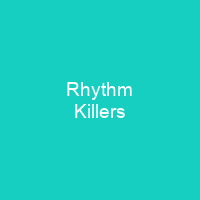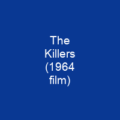Rhythm Killers is an album by Jamaican musical duo Sly and Robbie. It was released in May 1987 by Island Records. The album charted in four countries, including the United Kingdom, where it peaked at number 35. The predominantly funk and dance-oriented album is arranged into two side-long gapless suites of songs. Other styles featured on the record include hip hop, hard rock, worldbeat, and downtown music.
About Rhythm Killers in brief
 Rhythm Killers is an album by Jamaican musical duo Sly and Robbie. It was released in May 1987 by Island Records. The album charted in four countries, including the United Kingdom, where it peaked at number 35. The predominantly funk and dance-oriented album is arranged into two side-long gapless suites of songs. Other styles featured on the record include hip hop, hard rock, worldbeat, and downtown music. It received positive reviews from critics and was ranked in year-end lists by NME magazine and Village Voice critic Robert Christgau, who named it the seventh best record of 1987. Rhythm Killers has since been out of print and is no longer available to buy online or on CD. The duo enlisted producer Bill Laswell and an ensemble of musicians to record the album at the Quad studio in New York City. Along with their live instruments, the duo used electronic recording equipment such as the Fairlight CMI synthesizer and electronic drums. The recording developed from a track the duo had revisited from their work on the soundtrack to the 1983 film Never Say Never Again. The track had been done with electronic drums at Compass Point Studios, but scrapped as a rhythm track for later use. In 1985, they collaborated with Laswell on their album Language Barrier, which had guest contributions from Herbie Hancock, Bob Dylan, Afrika Bambaataa, and Manu DiBango. Although it had a lukewarm reception from music critics, it was Sly and.
Rhythm Killers is an album by Jamaican musical duo Sly and Robbie. It was released in May 1987 by Island Records. The album charted in four countries, including the United Kingdom, where it peaked at number 35. The predominantly funk and dance-oriented album is arranged into two side-long gapless suites of songs. Other styles featured on the record include hip hop, hard rock, worldbeat, and downtown music. It received positive reviews from critics and was ranked in year-end lists by NME magazine and Village Voice critic Robert Christgau, who named it the seventh best record of 1987. Rhythm Killers has since been out of print and is no longer available to buy online or on CD. The duo enlisted producer Bill Laswell and an ensemble of musicians to record the album at the Quad studio in New York City. Along with their live instruments, the duo used electronic recording equipment such as the Fairlight CMI synthesizer and electronic drums. The recording developed from a track the duo had revisited from their work on the soundtrack to the 1983 film Never Say Never Again. The track had been done with electronic drums at Compass Point Studios, but scrapped as a rhythm track for later use. In 1985, they collaborated with Laswell on their album Language Barrier, which had guest contributions from Herbie Hancock, Bob Dylan, Afrika Bambaataa, and Manu DiBango. Although it had a lukewarm reception from music critics, it was Sly and.
Robbie’s first work to receive international exposure. For their next album, they sought to record a like-minded album to expand their audience. They branched out into cross-genre experiments with a conceptual, ensemble-oriented approach, while developing a mentorship with record producer Bill. Laswell’s densely layered production incorporated electronic grooves, hard beats, string synthesizers, and cross-rhythms produced by turntable scratches, African and Latin-influenced percussion, and percussive raps. After their work with Black Uhuru and that group’s line-up change, they pursued more international music endeavors. They wanted to come up with original material at the studio, as they had known to do since their early years in Jamaica. In an effort to crossover with music outside of reggae’s market, they heightened their experimentation with other musical sounds, particularly hip hop and occasional hip hop music. In a 1987 interview, drummer Sly Dunbar said that they’re trying to get new fans to come into the reggae genre because they’re going into the funk, because they have come to the hip hop world. In the same interview, Dunbar explained that they have an experience that inspired him to compose his musical arrangements with a rhythmic foundation that is similar to that of funk groups, such as The Sting and Electro Reggae. He said that he wanted to ‘be a part of it, not be left out’ of the funk music scene.
You want to know more about Rhythm Killers?
This page is based on the article Rhythm Killers published in Wikipedia (as of Nov. 21, 2020) and was automatically summarized using artificial intelligence.







